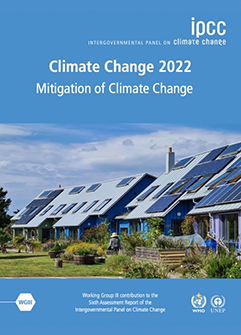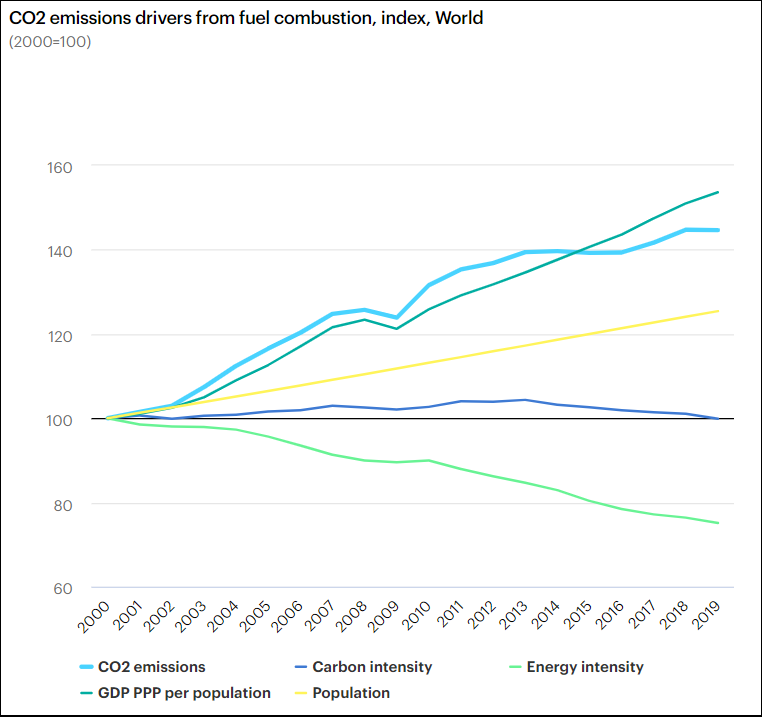The Critical Need for Emissions Reduction
Aditi Sinha, July 21, 2022
 On April 4, 2022, the Intergovernmental Panel on Climate Change (IPCC) published the final chapter of its sixth assessment report. The talking point was how to reduce greenhouse gas (GHG) emissions, and this is perhaps the most significant update of scientific knowledge on this topic since 2014.
On April 4, 2022, the Intergovernmental Panel on Climate Change (IPCC) published the final chapter of its sixth assessment report. The talking point was how to reduce greenhouse gas (GHG) emissions, and this is perhaps the most significant update of scientific knowledge on this topic since 2014.
The Problem: We are a Long Way From Achieving our Global Climate Objectives
The current level of GHG emissions is the highest in human history. We are currently not even close to complying with the Paris Agreement, which aims to limit global warming to 1.5°C by the end of the century compared to the pre-industrial era (~1850). At present if we don’t do something on a war footing, we are headed on the downhill disaster road of a raise of temperatures to 3.2°C.
GDP growth across major economic sectors (manufacturing, energy, transport, agriculture, and buildings) and population growth are the main causes of CO2 emissions increase, which are far from being outweighed by improvements in GDP energy intensity and the carbon intensity of energy use, illustrated by the International Energy Agency graph below. It clearly shows that the wealthiest 10% of households account for 40% of emissions, while the poorest 50% account for only 14% of emissions.

The solution: All Available Reduction Actions Must be Engaged Across all Sectors, Now
GHG emissions must peak by 2025 to limit global warming to 1.5°C, and emissions must be reduced by 40% by 2030.
People, Energy and Cities at the Heart of Decarbonisation
People: “Prevent, Improve, Change” is the IPCC’s approach to individual action. Indeed, demand-driven measures can reduce global GHG emissions by 40-70% by 2050. Behavioural change will have the greatest impact by shifting away from the use of private cars and limiting one’s air travel. Technological and procedural improvements will also contribute to decarbonisation through the deployment of electric vehicles renewable electricity and building renovation. Changing habits to reach a low-carbon world will also depend on using more public transportation and adopting a plant-based diet.
Energy: The drastic reduction of fossil fuel combustion is at the core of decarbonisation. Solar and wind power have the greatest potential for reduction, alongside other technologies (low-carbon electrification, use of hydrogen and sustainable biofuels, carbon capture etc). The good news is that the costs of renewable energy ave fallen. From 2010 to 2019, there has been a steady decline in the unit costs of solar power (85%), wind power (55%) and lithium-ion batteries (85%) for electricity storage. As a result, electricity systems powered primarily by renewable energies are proving ever more viable.

Cities: Urban centres are responsible for 70% of CO2 emissions and are home to over 55% of the world’s population. The main actions here are the reduction of energy consumption (behaviour change, energy efficiency, low-carbon buildings), electrification (renewable energies, implementation of electric mobility) and the improvement of carbon absorption and storage in urban environments (nature-based solutions, vegetation, protection of forest ecosystems, meadows, wetlands, etc.).
Sectoral Decarbonisation
All sectors must contribute to decarbonisation. However, the potential to reduce global CO2 emissions varies depending on the sector:
- Building: 27%,
- Manufacturing: 27%,
- Transport: 17%,
- Land use, land-use change and forestry (LULUCF): 12 %

The most important decarbonisation actions by sector are the following:
Buildings: The renovation of existing buildings must be accelerated more than ever, along with the construction of high energy performance buildings.
The entire life cycle must be considered:
- During the construction phase: low-emission building materials, a highly insulating building envelope and the integration of renewable energies are essential.
- At the operational level, the supply of low-carbon energy sources is central, especially for heating (e.g. heat pumps).
- In the end-of-life phase, the recycling and reuse of building materials contributes to the development of the circular economy.
Manufacturing: First, the deep decarbonisation of manufacturing requires new production processes using electricity, hydrogen, and low-carbon fuels (ammonia and synthetic fuels, bio-based fuels). Reducing such costs is strategic. Additionally, substitute emissive materials and energy efficiency are the other two main guidelines for decarbonising this industry, by adopting a life cycle assessment approach.
Transport: Road transport accounts for the largest share of transportation emissions. Light electric vehicles powered by low-emission electricity offer the greatest decarbonisation potential for land mobility on a life-cycle basis. Sustainable biofuels, low-emission hydrogen, and their by-products (including synthetic fuels) can contribute to the mitigation of CO2 emissions from shipping, aviation, and heavy land transport, but require production process improvements and cost reductions.
Land use, Land-Use Change and Forestry (LULUCF): Decarbonisation of this sector must involve the improvement of land management (protection of forests, restoration of ecosystems, reforestation, carbon sequestration in agriculture, etc.). Thus, the evolution of people’s diet will have a determining impact in the fight against climate change and will rely on prioritising plant-based foods and animal-based foods produced within resilient, sustainable, and low greenhouse gas emission systems.
Cross-Functional: Carbon dioxide removal processes (nature-based solutions, bioenergy carbon capture and storage (BECCS), direct air carbon capture and storage (DACCS), etc.) are essential to achieving net-zero. However, their degree of maturity, costs and storage capacity vary substantially.
Going Beyond Climate
All economic sectors and actors (supply and demand) must take part in climate action and work together. Indeed, the IPCC concludes its report by stating that effective and equitable climate governance requires the engagement of enterprises, citizens, political actors, young people, workers, the media, indigenous communities, and local communities.
There is an urgent need for more proactive policies to support the transition, first and foremost through carbon pricing. According to the IPCC, mitigation options costing $100/t CO2e or less could reduce global GHG emissions by at least half compared to the 2019 level by 2030. To meet a 1.5°C/2°C trajectory, investments need to be multiplied between 3 and 6 times by 2030.
Everyone can benefit from emissions reduction actions which would provide access to low-carbon and affordable energy, improved agricultural resilience, greater food security, enhanced adaptation to climate change, improved air, water, and soil quality, etc. More than ever, companies and territories must commit to a low carbon transition.
Aditi Sinha is Associate Director – Communications at Shakti Sustainable Energy Foundation.

